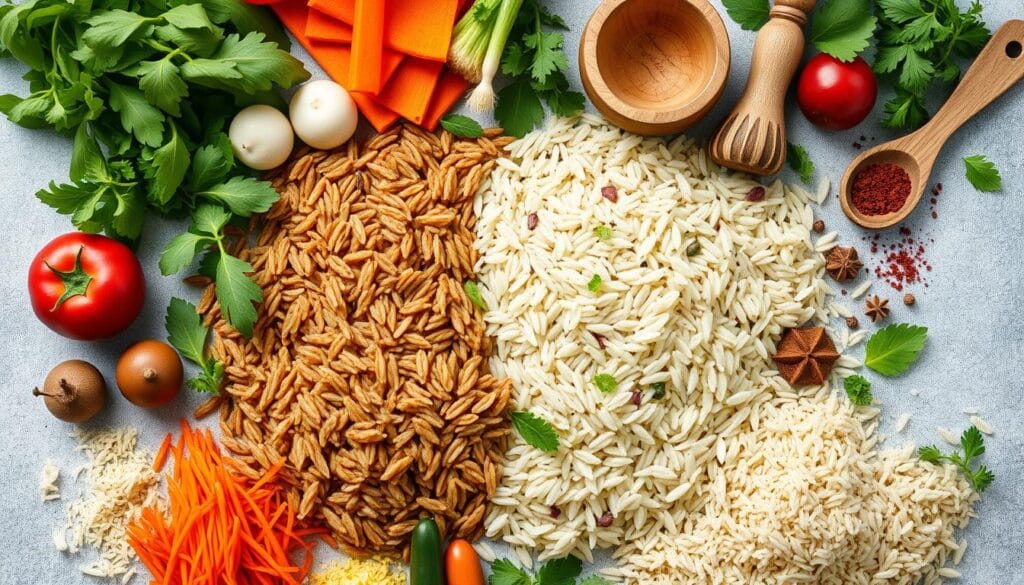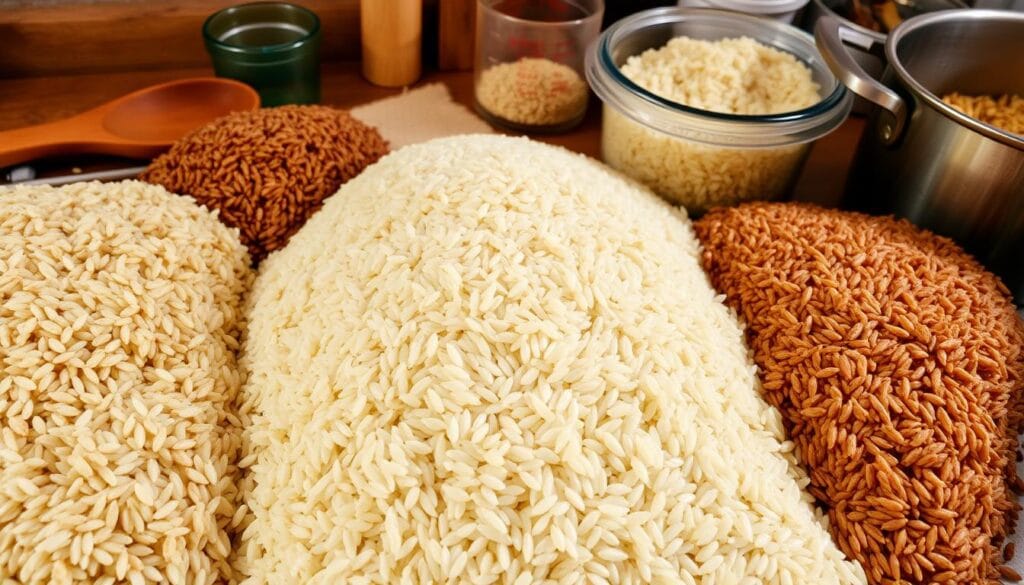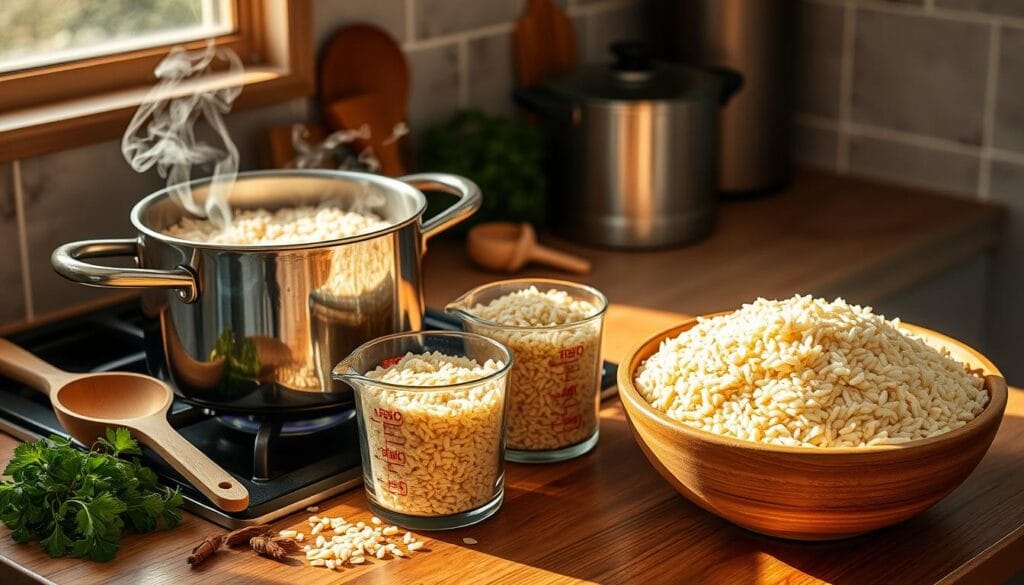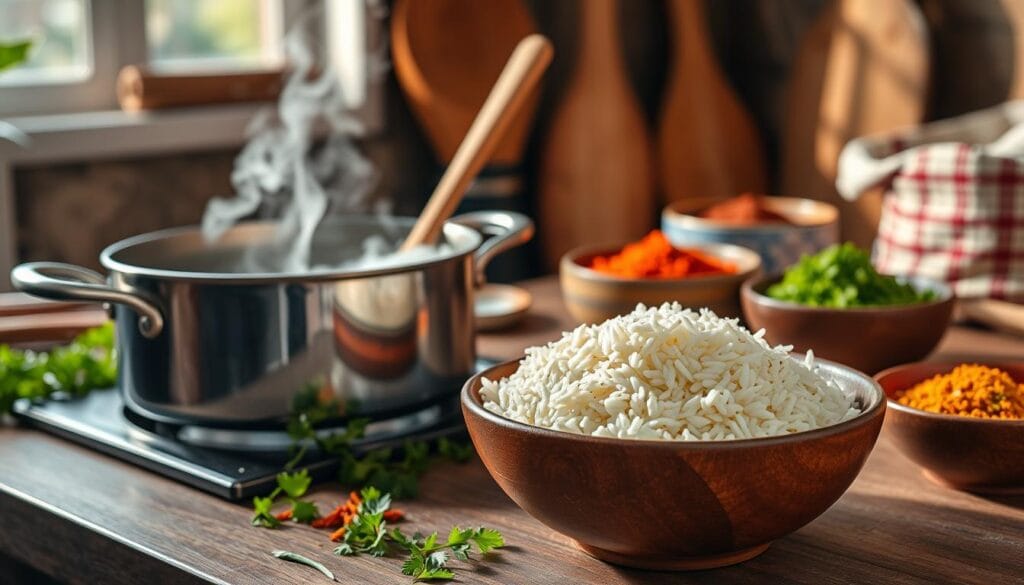Rice has been my culinary partner for years, making many meals special. Whether you cook at home or love to experiment in the kitchen, learning to cook brown and basmati rice is key. It boosts your cooking skills and adds tasty, nutritious food to your meals.
Cooking organic brown basmati rice is more than just following a recipe. It’s about mastering the techniques that make simple grains into a fluffy, perfect side dish. From rinsing to figuring out the right water ratio, every step is important. It helps create a delicious long grain brown basmati rice that will wow your loved ones.
In this guide, we’ll uncover the secrets of cooking brownbasmati rice. We’ll break down complex techniques into simple steps. This will make you confident and skilled in the kitchen.
Table of contents
Understanding Brown Rice
Rice is a staple food for millions worldwide, with over 40,000 different varieties to explore. Choosing the right rice can transform your culinary experience. Understanding healthy brown basmati and authentic basmati rice is key.
What is Brown Rice?
Premium brown basmati rice is a nutritional powerhouse. It keeps its outer bran and germ layers, unlike white rice. This gives it a brown color and nutty flavor. These layers add fiber and essential minerals, making brown rice healthier.
- Whole grain with intact nutritional layers
- Chewier texture compared to white rice
- Lower glycemic index (around 50)
- Rich in fiber and essential nutrients
What is Basmati Rice?
Authentic basmati rice is known for its distinctive aroma and long, slender grains. It comes from the foothills of the Himalayas. This rice variety has a unique fragrance and delicate flavor.
Nutritional Benefits Comparison

Both rice varieties offer impressive nutritional benefits. Brown basmati rice balances taste and nutrition well. It has a glycemic index of about 50, lower than white basmati rice’s 58.
| Rice Type | Glycemic Index | Key Nutritional Benefits |
|---|---|---|
| Brown Basmati Rice | 50 | High fiber, more nutrients, slower blood sugar absorption |
| White Basmati Rice | 58 | Quick energy, lighter texture |
“Rice is not just food, it’s a cultural experience that connects us to centuries of culinary tradition.” – Anonymous Chef
Whether you prefer brown rice’s robust nutrition or basmati’s aromatic qualities, knowing about these rice varieties helps you make better dietary choices.
Preparing Your Brown Rice
Preparing the perfect rice is all about the details. Whether you’re using aromatic brownbasmati or gluten-free brown basmati, getting it right is key. It makes your cooking journey even more enjoyable.

Rinsing Techniques for Optimal Flavor
Rinsing rice is a step many miss. For the best brown basmati, here’s what to do:
- Place rice in a fine-mesh strainer
- Rinse under cool running water
- Gently move rice around to remove excess starch
- Continue until water runs clear
“Clean rice is the foundation of a perfect dish” – Professional Chef Recommendation
Soaking: A Game-Changing Technique
Soaking can change your rice-cooking game. Especially for brown rice, it helps a lot:
- Reduces cooking time
- Makes it easier to digest
- Improves the texture
Precise Water Measurements
The secret to perfect rice is using the right water ratio. For basmati, use 1.5 cups of water for every 1 cup of rice. Brown rice needs 2 cups of water for 1 cup of rice.
| Rice Type | Water Ratio | Cooking Time |
|---|---|---|
| White Basmati | 1.5:1 | 15-18 minutes |
| Brown Basmati | 2:1 | 25-30 minutes |
For the best gluten-free brown basmati, always measure carefully. Adjust cooking time based on your rice type.
Cooking Brown Rice: Step-by-Step Guide
Cooking brown rice might seem hard, but with the right steps, you’ll get it right every time. Knowing the difference between basmati and brown basmati helps pick the best cooking method for your dish.

Brown rice needs more water and time to cook than white rice because of its outer layer. It’s also healthier, full of B-vitamins, iron, and zinc.
Instant Pot Method
The Instant Pot is a quick and easy way to cook brown rice. Here’s how to do it:
- Rinse rice well to remove extra starch
- Use a 1:1.25 rice to water ratio
- Set Instant Pot to high pressure for 22 minutes
- Let it release pressure naturally for 10 minutes
- Fluff the rice with a fork before serving
Stovetop Method
Stovetop cooking is a classic way to make brown rice:
- Use 1 ¾ cups water for each cup of rice
- Bring water to a boil
- Lower heat and simmer for 40-45 minutes
- Let it rest for 5 minutes after cooking
Common Pitfalls to Avoid
When cooking brown rice, avoid these common problems:
| Problem | Solution |
|---|---|
| Mushy Rice | Reduce water slightly and check cooking time |
| Undercooked Rice | Add more water, extend cooking time |
| Burnt Bottom | Use low heat, stir occasionally |
Pro tip: Always check your specific rice package for precise cooking instructions, as varieties can differ slightly in water requirements and cooking times.
“Perfecting brown rice is an art that combines patience and technique.” – Culinary Experts
Cooking Basmati Rice: Step-by-Step Guide
Basmati rice is famous for its unique smell and soft taste. To cook brown basmati, you need to know some special techniques. These methods will help you make perfect rice every time.
Traditional Boiling Method
The traditional way to cook basmati rice includes a few important steps:
- Rinse the rice well until the water is clear
- Use a 1.5:1 water-to-rice ratio for white basmati
- Soak rice for 20-30 minutes before cooking
- Bring water to a rolling boil
- Reduce heat and simmer covered for 15-18 minutes
Absorption Method Explained
Brown basmati rice tastes nuttier and stronger than white basmati. Here’s how to use the absorption method:
- Measure 2 cups of water per 1 cup of brown basmati rice
- Bring water and rice to a boil
- Reduce heat to low
- Cover and simmer for 40-45 minutes
- Let rice rest for 10 minutes after cooking
Tips for Fluffy Rice
Here are some tips to make fluffy basmati rice:
| Technique | Benefit |
|---|---|
| Minimal Stirring | Prevents rice from becoming sticky |
| Proper Resting Time | Allows steam to redistribute |
| Fluffing with Fork | Separates grains gently |
Pro tip: Always let your rice rest for 5-10 minutes after cooking to achieve the perfect texture.

Remember, practice makes perfect when cooking basmati rice. Each batch will help you refine your technique!
Flavoring Your Rice Dishes
Make your brown basmati rice recipe stand out by adding flavor and nutrition. Cooking rice doesn’t have to be dull. With the right methods, you can make it a true culinary delight.
Herbs and Spices to Elevate Your Rice
Discover new tastes by trying different herbs and spices. When cooking your brown basmati rice, consider these options:
- Turmeric for a golden color and earthy flavor
- Fresh cilantro for brightness
- Cumin seeds for warmth
- Cardamom pods for subtle sweetness
Broth: A Flavor Game-Changer
Use broth instead of water to enhance your basmati rice. Chicken, vegetable, or seafood broth can make your rice truly special.
Adding Proteins and Vegetables
Make a full meal by adding proteins and vegetables to your rice. Some great choices are:
- Sautéed chicken or tofu
- Roasted vegetables like bell peppers
- Scrambled eggs
- Edamame or peas
*Pro tip: Add mix-ins during the last 5-7 minutes of cooking to maintain texture and prevent overcooking.*
Try these methods to turn your rice into a nutritious, flavorful main dish. It’s sure to be a hit with everyone.
Combining Basmati Rice
Exploring rice combinations can change your cooking. Mixing brown and basmati rice offers a special mix of nutrition and taste.
Health Benefits of Rice Combinations
Blending brown and basmati rice brings many health benefits. It’s a great way to make your meals more nutritious.
- Increased fiber content from brown rice
- Balanced carbohydrate profile
- Enhanced protein absorption
- Improved mineral intake
Nutritional Comparison of Rice Varieties
| Rice Type | Calories | Protein | Fiber |
|---|---|---|---|
| Brown Basmati | 121/100g | 3.5g | 1g |
| White Basmati | 130/100g | 2.7g | 0.4g |
Creative Mixed Rice Recipes
Royal brown basmati rice is perfect for new dishes. Here are some recipe ideas:
- Mediterranean Rice Pilaf
- Spicy Vegetable Rice Bowl
- Herb-Infused Mixed Rice Salad
When cooking mixed rice, pay attention to each grain’s needs. Try different cooking methods for the best taste and texture.
“Blending rice types isn’t just cooking – it’s culinary creativity!” – Chef Maria Rodriguez
Your rice journey begins now. Try brown basmati rice to make your meals healthier and tastier.
Storing Leftover Rice
Keeping brown rice fresh is key. It’s important to know how to store it right. This way, you can enjoy its taste and health benefits for longer.
Best Practices for Refrigeration
Quick cooling is essential when storing rice. Spread it on a shallow dish to cool faster. Here’s how to keep your rice fresh:
- Cool rice within one hour of cooking
- Store in airtight containers
- Refrigerate at temperatures below 40°F
- Consume within 3-4 days
Freezing Your Cooked Rice
Freezing is a great way to keep rice longer. If you buy basmati rice in bulk, freeze it for later. This saves time and keeps your rice fresh.
| Storage Method | Duration | Best Practices |
|---|---|---|
| Refrigeration | 3-4 days | Use shallow, airtight containers |
| Freezing | Up to 6 months | Use freezer-safe bags or containers |
Reheating Tips for Optimal Taste
Reheating rice needs care to keep it tasty and safe. Always heat it to 165°F. Pro tip: Add a bit of water to keep it moist.
By following these tips, you’ll enjoy your rice more. It will taste great and be safe to eat.
Common Rice Cooking FAQs
Cooking rice can be tricky, even with different types like brown rice. Whether you’re making a small batch or 20 lbs, knowing some key techniques can help. This way, you’ll get perfect results every time.
How to Tell When Brown Rice is Done?
Figuring out when basmati rice is cooked right takes some skill. Here’s what to look for:
- Texture becomes tender but slightly chewy
- Water is completely absorbed
- Grains appear slightly split at the ends
- Cooking time reaches 40-45 minutes
Avoiding Sticky Rice When Cooking
To cook brown rice without it sticking, follow these tips:
- Rinse rice thoroughly before cooking
- Use the correct water-to-rice ratio (typically 2¼ cups water per 1 cup rice)
- Avoid stirring during cooking
- Let rice rest for 10-15 minutes after cooking
Cooking Brown and Basmati Rice Together
“Mixing rice varieties can create interesting flavor profiles and nutritional combinations.”
When cooking basmati rice together, keep these tips in mind:
- Choose rice varieties with similar cooking times
- Adjust water ratio to accommodate different absorption rates
- Pre-soak brown rice to reduce overall cooking time
- Start with small batches to perfect your technique
Pro tip: For large quantities like 20 lbs of basmati rice, increase cooking time by 5-10 minutes and ensure even heat distribution.
FAQ
What is the difference between basmati and brown basmati rice?
Is brown basmati healthier than white basmati?
How do I cook brown basmati rice perfectly?
What does brown basmati rice taste like?
How much water should I use when cooking brown basmati rice?
Can I cook brown and white basmati rice together?
Where can I buy high-quality brown basmati rice?
What are the main health benefits of brown basmati rice?
How do I prevent brown basmati rice from becoming sticky?
Can I cook large quantities of brown basmati rice at once?
Conclusion: Enjoying Your Delicious Rice Dishes
Your rice cooking adventure doesn’t end here. You now know how to make amazing dishes with brown and basmati rice. Each brand offers its own texture and flavor, opening up new culinary paths.
Try rice recipes from all over the world to make your kitchen a global spot. From Indian biryanis to Spanish paellas, there’s always something new to try. These rice varieties are also great for those who want healthy, tasty meals.
Now, your rice journey is just starting. Experiment with different cooking methods and mix brown basmati rice. Don’t be shy to try new flavors. Every meal is a chance to find something new and exciting.
Creative Serving Suggestions
Think outside the box with brown basmati rice. Use it as a base for grain bowls, stuffed peppers, or even desserts. Brown rice’s nutty taste goes well with roasted veggies, while basmati rice adds a special aroma to stir-fries and salads.
Exploring Global Rice Recipes
Explore international dishes that showcase brown
basmati rice. Try Middle Eastern pilafs or Southeast Asian rice puddings. Each culture brings its own twist to these grains.
Encouragement to Experiment in the Kitchen
Cooking is a journey of learning. Your skills will improve with each dish. Trust your instincts, accept mistakes, and enjoy the process of mastering rice cooking.

